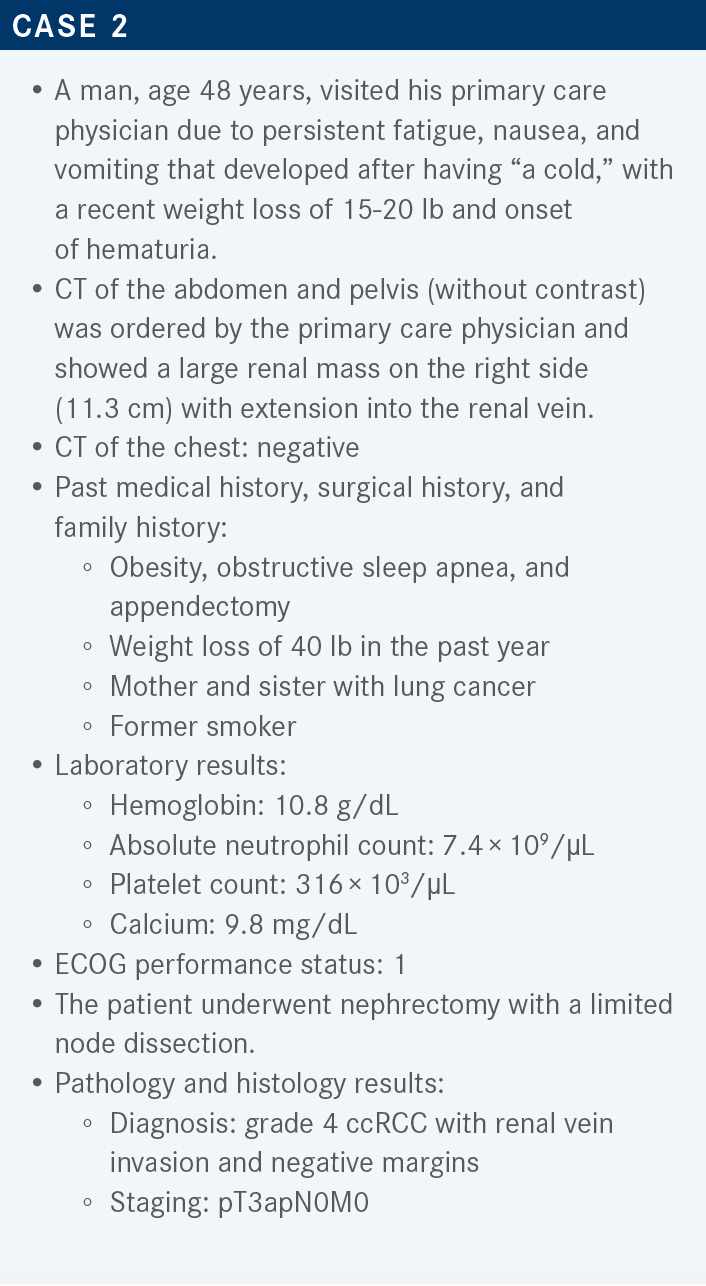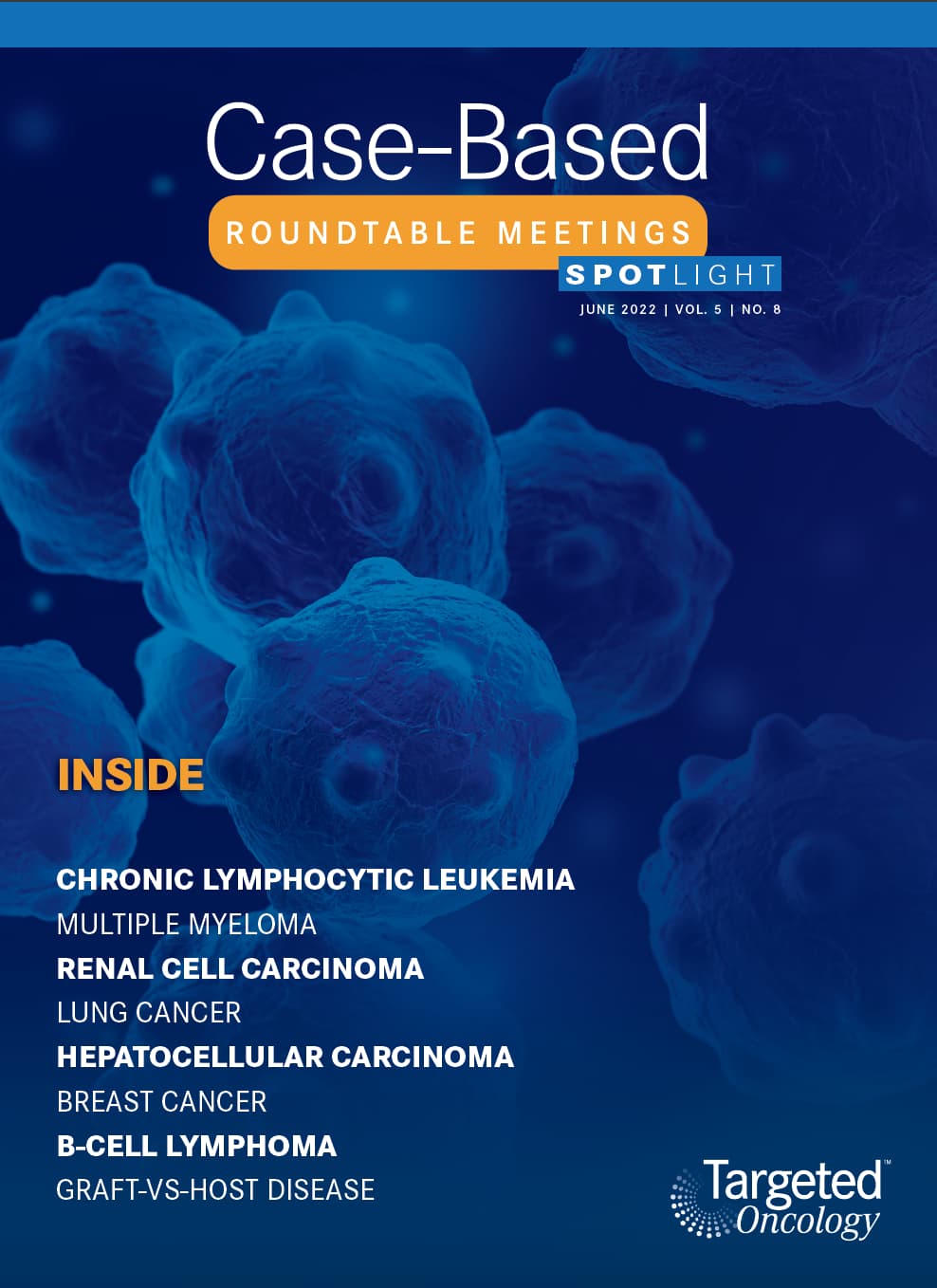Lee and McGregor Discuss Methods to Integrate New Approaches in RCC Treatment
During a Targeted Oncology case-based event, Chung-Han Lee, MD, PhD, and Bradley A. McGregor, MD, discussed the case of a patient with recurrent metastatic renal cell carcinoma and that of a patient at risk of recurrence following resection.

Chung-Han Lee, MD, PhD (Comoderator)
Medical Oncologist
Memorial Sloan Kettering Cancer Center
New York, NY

Bradley A. McGregor, MD (Comoderator)
Clinical Director, Lank Center for Genitourinary Oncology
Dana-Farber Cancer Institute
Boston, MA

Targeted OncologyTM: What second-line therapy are you most likely to recommend for this patient?
LEE: Popular choices include a single-agent VEGF-targeted tyrosine kinase inhibitor [TKI] [eg, axitinib (Inlyta) or cabozantinib (Cabometyx)], a VEGF-TKI combination [specifically, lenvatinib (Lenvima) plus everolimus (Afinitor)], and an immune checkpoint inhibitor [ICI] regimen [eg, nivolumab (Opdivo) with or without ipilimumab (Yervoy)].
What are the National Comprehensive Care Network (NCCN) guidelines for subsequent ccRCC therapy?
Listed as preferred regimens are single-agent nivolumab, single-agent cabozantinib, and the combination of lenvatinib plus everolimus, all supported by category 1 data. I’m not sure many of us would choose nivolumab after progression on pembrolizumab [Keytruda]. Axitinib is listed among the “other recommended” regimens and is supported by category 1 data.1
From your experience, are cabozantinib and the combination of lenvatinib and everolimus tolerated equally well, or is one tolerated better than the other?
We [use these] treatments at the regulatory-approved doses: cabozantinib at 60 mg, lenvatinib at 18 mg, and everolimus at 5 mg. I think tolerability is very [patient specific]. Both regimens tend to be challenging at the FDA-approved doses, and most patients will require a dose reduction. One of the challenges with something like lenvatinib plus everolimus is that you must manage toxicity from 2 different types of drugs and [you must be able to correctly] attribute the toxicities [to their respective] medications. But each drug probably can be reduced to a dose that has acceptable levels of toxicity.
If a patient received axitinib plus pembrolizumab as first line and had a good response but then progressed, would you give this patient axitinib again?
[In that case, there would] probably be no indication for giving axitinib again. [We need to keep in mind that the NCCN] guidelines don’t take prior therapies [into account].

What data support the second-line regimens that are listed as “preferred” by the NCCN?
The use of nivolumab is supported by the results of the CheckMate 025 study [NCT01668784], in which patients had TKI-refractory disease. The primary end point was overall survival [OS], [and the comparator was everolimus]. [The experimental arm] demonstrated an objective response rate [ORR] of 25%, a median progression-free survival [PFS] of 4.6 months, and an OS of 25.0 months [HR, 0.73; 95% CI, 0.57-0.93; P = .002]. About 8% of patients required discontinuation [of treatment] due to adverse events [AEs].2
The results of the phase 3 METEOR study [NCT01865747] support the use of cabozantinib, which was compared with everolimus in this trial. Again, patients had TKI-refractory disease, and the primary end point was PFS. [In the experimental arm], there was a median ORR of 17%, a median PFS of 7.4 months [HR, 0.51; 95% CI, 0.41-0.62; P < .0001], and a median OS of 21.4 months. About 62% of patients required a dose reduction and 12% of patients had to discontinue treatment due to AEs.3
Lastly, the combination of lenvatinib plus everolimus was compared with lenvatinib monotherapy and with everolimus monotherapy in the phase 2 Study 205 [NCT01136733]. Again, this trial was conducted in the context of TKI-refractory disease, and the primary end point was PFS. In this study, the ORR [of patients who received lenvatinib plus everolimus] was 43%, median PFS was 14.6 months [HR vs everolimus, 0.40; 95% CI, 0.24-0.68; P = .0005], and median OS was 25.5 months. About 71% of patients required dose reduction, and about 24% of patients required discontinuation of treatment due to toxicity.4
Could you summarize the properties of VEGF-TKIs?
Sunitinib [Sutent] and sorafenib [Nexavar] are first-generation TKIs. Some of the next-generation TKIs, with slightly different spectrums, include pazopanib [Votrient], cabozantinib, and lenvatinib. Axitinib and tivozanib [Fotivda] are more recent TKIs; they have very high specificity for VEGFR-1, VEGFR-2, and VEGFR-3 and lower specificity for things like fibroblast growth factor receptor and c-kit, compared with other regimens.5
What data supported the approval of tivozanib?
The phase 3 TIVO-3 study [NCT02627963] led to the regulatory approval of tivozanib.6 Patients in this study had advanced or metastatic ccRCC and had progressed on 2 or 3 prior systemic therapies, including at least 1 VEGFR-targeted therapy. Patients were stratified [with respect to the nature of their prior treatment]: a VEGFR TKI plus a checkpoint inhibitor; 2 VEGFR TKIs; or a VEGFR TKI plus another agent. Patients were also stratified with respect to their International Metastatic RCC Database Consortium risk status (favorable, intermediate, or poor).7 [With regard to prior therapies], about half of the patients in each arm had received 2 prior ICIs. About a quarter of the patients in each arm had received an ICI plus a VEGFR-targeted therapy, and about a quarter had received a VEGFR-targeted therapy plus some other type of agent.7,8
Patients were randomly assigned to receive either oral tivozanib (1.34 mg per day; 3 weeks on, 1 week off) or oral sorafenib (400 mg twice daily, continuously for the 4-week cycle). Patients were treated until disease progression or unacceptable toxicity.7
This was a positive study, with a median PFS of 5.6 months in the tivozanib arm vs 3.9 months in the sorafenib arm [HR, 0.73; 95% CI, 0.56-0.94; P = .016]. The percentage of patients exhibiting PFS at 2 years was 18% in the tivozanib arm and 5% in the sorafenib arm, which ended up showing active amounts of disease. [Notably], even though both tivozanib and axitinib are thought to be potent and selective inhibitors of VEGFR-1, VEGFR-2, and VEGFR- 3, prior treatment with axitinib did not affect the efficacy or tolerability of tivozanib in the third-line or fourth-line setting. The percentage of patients exhibiting a 1-year duration of response was 71% for tivozanib and 46% for sorafenib.9,10 Long-term landmark analysis again favored tivozanib over sorafenib, with an HR of 0.624 [95% CI, 0.49-0.79].11
The ORR was 23% in the tivozanib arm and 11% in the sorafenib arm. The disease control rate was 82% vs 69% for the respective arms. Most of the responses were partial; no [complete responses] were observed. The HR for OS was 0.91 [95% CI, 0.716-1.165; P = .47].7 They are continuing to watch the OS data, and the most recent OS data showed an HR of 0.89 [95% CI, 0.70-1.14].11
Overall, the tivozanib was well tolerated. Relative to the sorafenib arm, the tivozanib arm exhibited slightly more hypertension [for grade 3, 20% of patients in the tivozanib arm vs 14% of patients in the sorafenib arm], probably related to the VEGFR blockade, but fewer instances of diarrhea for grade 3, 2% vs 9%, respectively. Fatigue was similar between the arms for grade 3, 4% vs 5%, respectively. The risk of palmar-plantar erythrodysesthesia syndrome was quite low for the tivozanib arm for grade 3, 1% vs 10%, respectively. Finally, very few patients developed rash of grade 3 [at] 0% vs 7%, respectively, or grade 4 at 0% vs 1%, respectively.12
Dose interruption was required for 50% of the patients in the tivozanib arm vs 64% in the sorafenib arm. Dose reduction was required for 25% vs 39%, respectively. Discontinuation due to toxicity was required for 21% vs 30%, respectively. Overall, tivozanib showed better tolerability, just [in terms of a longer possible duration of treatment].8,12,13
What are some practical considerations for physicians using tivozanib?
Toxicity management is like that for other TKIs with respect to diarrhea, nausea, and vomiting. The dosing schedule is 3 weeks on treatment followed by 1 week off, and the starting dose is 1.34 mg; the dose can be reduced to 0.89 mg as needed. This drug can be given with or without food.14

How do you assess risk of recurrence for this patient?
MCGREGOR: The TNM [tumor, node, metastasis] staging is critically important; in this case, T3 suggests a high risk of recurrence, as does a grade of 4. Additionally, a tumor size greater than 7 cm and the presence of renal vein invasion [with likely lymphovascular invasion] represent a high risk for recurrence.1
There are many different models for assessing recurrence risk, including the following: UCLA Integrated Staging System [UISS]; Stage, Size, Grade, and Necrosis [SSIGN]; Leibovich; Memorial Sloan-Kettering Cancer Center; Kattan; Yaycioglu; Karakiewicz; and Cindolo. There is also the Fox Chase online tool…based on the ASSURE trial [NCT00326898], and [in creating this tool] they looked at the risk of recurrence [relative to] a variety of factors. It’s very simple; you plug in your numbers and it gives you a risk for recurrence. This can be quite useful now that we have more effective adjuvant therapies.
In my practice, I didn’t tend to use [predictive models] as much [as I do now] because I didn’t want to know how the patient was going to do, because it wouldn’t change anything. But now that we have options that [can change the patient’s outcome], I think the models are becoming increasingly helpful. I think it is probably useful to become familiar with one of these different models, because it can help you counsel the patient. Essentially, all these models use TNM, looking at the nodes [and] performance status. Some of them [consider] different things, such as necrosis, histology, or symptoms. But many models [consider the same factors] and are just based on different data sets. The most important thing is to become familiar with a model that you can use in your practice.
How would the UISS scoring system be applied to this patient?
The UISS scoring system [would consider] the localized disease, stage T3, grade 4, and the [ECOG] performance status of 1. [This model would] put him in the high-risk group, which has a 5-year survival rate of about 55%. It’s quite unnerving [for a patient to learn] that they have a 45% chance of dying of cancer in the next 5 years, so we’ve been trying to help these patients and to improve outcomes.
What guidelines does the NCCN offer for initial workup of a kidney mass?
It’s important [to note] that [simply] having kidney cancer doesn’t mean [that a patient requires] adjuvant therapy. According to the NCCN, for patients with stage I disease (T1a and T1b), surgery and surveillance are options. For patients with stage II disease, surveillance is an option; pembrolizumab is [of fered as an option] only for grade 4 tumors with or without sarcomatoid features. At stage III, a clinical trial [is] preferred [if there is clear cell histology], and surveillance and adjuvant pembrolizumab or sunitinib are other options.1
What would you do in the case of a patient who does not fit the guidelines? Consider, for example, an otherwise healthy woman, age 61 years, with RCC of grade 4 but T1. The patient has had a nephrectomy, no lymph node was taken out, and there are sarcomatoid features. The mass is 6.9 cm, which is 0.1 cm less than the guideline cutoff. Should she be offered adjuvant therapy?
The trial of pembrolizumab (KEYNOTE-564; NCT03142334) did allow for patients with T2a, grade IV disease. That trial wasn’t looking at just T2b disease. A patient whose mass is just 0.1 cm away from that limit is clearly a higher-risk patient. [Adjuvant therapy] is certainly something you could talk about. However, the data [only show] disease-free survival benefit.15
REFERENCES
1. NCCN. Clinical Practice Guidelines in Oncology. Kidney cancer, version 4.2022. Accessed May 20, 2022. https://bit.ly/3x0LI7X
2. Motzer RJ, Escudier B, McDermott DF, et al; CheckMate 025 Investigators. Nivolumab vs everolimus in advanced renal-cell carcinoma. N Engl J Med. 2015;373(19):1803-1813. doi:10.1056/NEJMoa1510665
3. Choueiri TK, Escudier B, Powles T, et al; METEOR Investigators. Cabozantinib vs everolimus in advanced renal cell carcinoma (METEOR): final results from a randomised, open-label, phase 3 trial. Lancet Oncol. 2016;17(7):917-927. doi:10.1016/S1470-2045(16)30107-3
4. Motzer RJ, Hutson TE, Glen H, et al. Lenvatinib, everolimus, and the combination in patients with metastatic renal cell carcinoma: a randomised, phase 2, open-label, multicentre trial. Lancet Oncol. 2015;16(15):1473-1482. Published correction appears in Lancet Oncol. 2016;17(7):e270. Published correction appears in Lancet Oncol. 2018;19(10):e509.
5. Fogli S, Porta C, Del Re M, et al. Optimizing treatment of renal cell carcinoma with VEGFR-TKIs: a comparison of clinical pharmacology and drug-drug interactions of anti-angiogenic drugs. Cancer Treat Rev. 2020;84:101966. doi:10.1016/j.ctrv.2020.101966
6. FDA approves tivozanib for relapsed or refractory advanced renal cell carcinoma. FDA. March 10, 2021. Accessed May 23, 2022. https://bit. ly/38JdH3L
7. Verzoni E, Escudier B, Hutson TE, et al. TIVO-3: durability of response and updated overall survival of tivozanib vs sorafenib in metastatic renal cell carcinoma (mRCC). J Clin Oncol. 2021;39(suppl 15):4546. doi:10.1200/ JCO.2021.39.15_suppl.4546
8. Escudier B, Rini BI, Pal SK, et al. TIVO-3: age-related tolerability outcomes of tivozanib vs sorafenib in metastatic relapsed or refractory renal cell carcinoma, a subgroup analysis of the TIVO-3 clinical trial. J Clin Oncol. 2021;39(suppl 15):e16553. doi:10.1200/JCO.2021.39.15_suppl.e16553
9. Pal SK, Escudier BJ, Atkins MB, et al. Final overall survival results from a phase 3 study to compare tivozanib to sorafenib as third- or fourth-line therapy in subjects with metastatic renal cell carcinoma. Eur Urol. 2020;78(6):783- 785. doi:10.1016/j.eururo.2020.08.007
10. Rini BI, Pal SK, Escudier B, et al. TIVO-3: tivozanib in patients with advanced renal cell carcinoma (aRCC) who have progressed after treatment with axitinib. Paper presented at: American Society of Clinical Oncology 2021 Genitourinary Cancers Symposium; February 11-13, 2021; virtual. Accessed May 22, 2022. https://bit.ly/3xlvEPD
11. Atkins MB, Verzoni E, Escudier B, et al. Long-term PFS from TIVO-3: tivozanib (TIVO) versus sorafenib (SOR) in relapsed/refractory (R/R) advanced RCC. J Clin Oncol. 2022;40(suppl 6):362. doi:10.1200/ JCO.2022.40.6_suppl.362
12. Rini BI, Pal SK, Escudier BJ, et al. Tivozanib vs sorafenib in patients with advanced renal cell carcinoma (TIVO-3): a phase 3, multicentre, randomised, controlled, open-label study. Lancet Oncol. 2020;21(1):95-104. doi:10.1016/ S1470-2045(19)30735-1
13. Pal SK, McDermott DF, Escudier B, et al. Temporal characteristics of treatment-emergent adverse events and dose modifications with tivozanib and sorafenib in the phase 3 TIVO-3 study of relapsed or refractory mRCC. J Clin Oncol. 2021;39(suppl 15):4567. doi:10.1200/JCO.2021.39.15_suppl.4567
14. Fotivda. Prescribing information. AVEO Pharmaceuticals; 2021. Accessed May 23, 2022. https://bit.ly/38HIrlI
15. Choueiri TK, Tomczak P, Park SH, et al; KEYNOTE-564 Investigators. Adjuvant pembrolizumab after nephrectomy in renal-cell carcinoma. N Engl J Med. 2021;385(8):683-694. doi:10.1056/NEJMoa2106391

Enhancing Precision in Immunotherapy: CD8 PET-Avidity in RCC
March 1st 2024In this episode of Emerging Experts, Peter Zang, MD, highlights research on baseline CD8 lymph node avidity with 89-Zr-crefmirlimab for the treatment of patients with metastatic renal cell carcinoma and response to immunotherapy.
Listen
Beyond the First-Line: Economides on Advancing Therapies in RCC
February 1st 2024In our 4th episode of Emerging Experts, Minas P. Economides, MD, unveils the challenges and opportunities for renal cell carcinoma treatment, focusing on the lack of therapies available in the second-line setting.
Listen